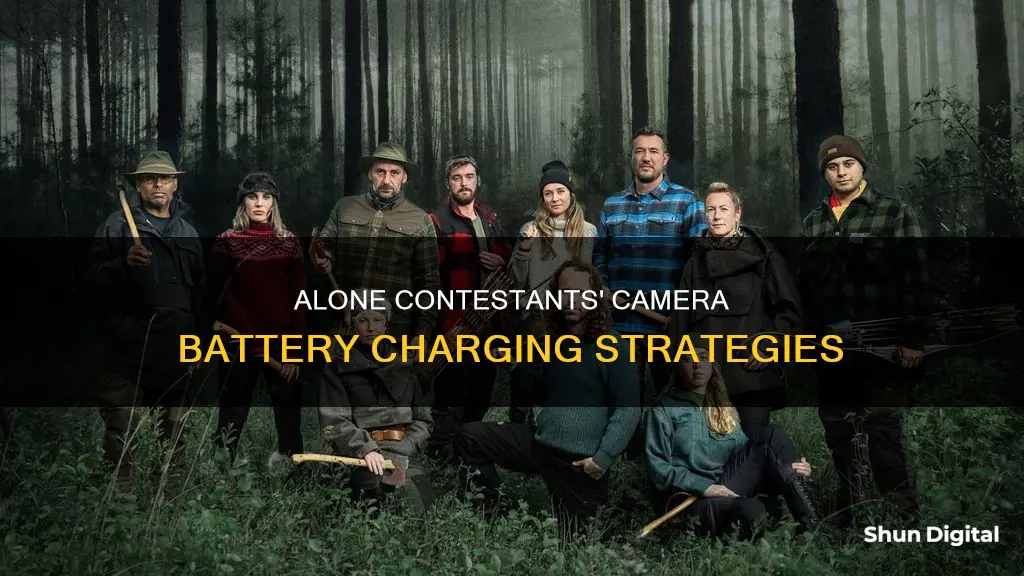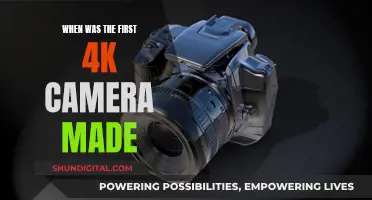
In the TV show Alone, contestants are left to fend for themselves in the Canadian wilderness. They are given minimal equipment and tasked with surviving for as long as possible. As part of the show, they are required to film their every move, which raises the question of how they keep their camera batteries charged. It turns out that the batteries are regularly replenished through a well-planned system of dead drops or drop boxes. Contestants have a drop-off place where they leave their spent cameras and pick up newly charged ones, ensuring they remain alone in the wilderness while still being able to document their journey.
| Characteristics | Values |
|---|---|
| Number of contestants | 10-11 |
| Items taken | 10 |
| Example items | Axe, fish hooks, tarpaulin |
| Communication with outside world | Satellite phone |
| Number of cameras | 5 |
| Camera type | GoPro |
| Camera angles | 2 |
| Battery replacement method | Drop box system |
| Drop box contents | Waterproof box with memory cards and camera batteries |
| Drop box frequency | Set times |
| Additional requirements | Daily text check-in |
| Medical support | Weekly medical check-up by a physician |
| Rechargeable batteries | Yes |
| Recharging stations | Yes |
What You'll Learn

Producers use a dead-drop system to replenish batteries
The TV series "Alone" presents an intriguing concept of dropping contestants in remote wilderness areas and challenging them to survive with minimal equipment. The contestants are tasked with enduring harsh conditions while hunting, fishing, and building shelters, all while documenting their experiences. This raises the question: how do they keep their camera batteries charged?
The answer lies in the implementation of a well-planned dead-drop system by the producers. Dead drops refer to predetermined locations where contestants can access essential filming supplies. Here's how it works:
When the contestants first arrive at their designated locations, they are provided with cameras and several batteries. They are responsible for ensuring that the cameras remain charged and operational throughout their journey. To facilitate this, the producers establish specific dead-drop sites, carefully chosen to ensure the contestants' continued isolation.
The contestants are given a GPS device and coordinates to locate these discreet drop-off sites. Upon receiving instructions to reach a particular location, they can pick up newly charged cameras and replacement batteries. This process is designed to be a solitary one, maintaining the integrity of the contestants' isolation.
The dead-drop system functions as a swapping mechanism. Contestants leave their depleted batteries and used cameras at the site, which the production team then collects. This exchange ensures uninterrupted filming for the contestants and provides the production team with valuable footage for editing and quality checks.
The implementation of the dead-drop system is a clever solution to the technical challenges posed by the show's remote filming locations. It allows the contestants to focus on their survival endeavours while still capturing their experiences for viewers to witness.
Charging Your Polaroid: A Step-by-Step Guide to Powering Up
You may want to see also

Contestants are responsible for ensuring cameras are charged
Contestants on the TV show "Alone" are responsible for ensuring their cameras are charged. They are given five cameras, mainly GoPros, and are expected to film their every move from at least two angles. While the show's premise is that the contestants are left to fend for themselves in the wilderness, completely alone, the batteries are regularly replenished.
The contestants access essential filming supplies such as memory cards and camera batteries using a drop box system. This involves a waterproof box that is emptied and replenished at set times. The drop-off place is carefully chosen to ensure the contestants remain genuinely alone. They are given a GPS device and coordinates to locate the quiet drop site.
The contestants then swap their old equipment for new, fully charged cameras and batteries. This system of dead drops ensures the contestants can continue filming without interruption and allows viewers to enjoy an unfiltered look at the contestants' journey.
While the contestants are responsible for ensuring their cameras are charged, the show's producers have implemented this well-planned system to ensure the contestants are always equipped with the necessary resources.
Charging Your Fujifilm Camera: A Step-by-Step Guide
You may want to see also

Batteries are swapped out at medical check-ins
The TV show "Alone" is a unique survival show that tests the resilience and survival skills of contestants who are left to fend for themselves in the wilderness. While the contestants are responsible for charging their own camera batteries, the show's producers have devised a clever system to facilitate this process without disrupting the contestants' isolation.
One way the show ensures the contestants have access to charged batteries is through medical check-ins. The contestants receive a weekly medical check-up from a production team physician. During these check-ins, the production team can swap out depleted batteries for fully charged ones. This process ensures that the contestants can continue filming their journey without running out of power, while also allowing the production team to collect valuable footage for the show.
The battery swap system is carefully coordinated to maintain the integrity of the show and the contestants' isolation. Contestants are provided with a limited number of batteries and are responsible for managing their power usage until the next swap. This adds an extra layer of challenge to their survival experience, as they must conserve power and ensure their cameras are operational at all times.
In addition to the medical check-ins, the show also employs a drop box system for replenishing batteries and other essential filming supplies. The drop box system involves predetermined locations where contestants can pick up freshly charged batteries and drop off depleted ones without coming into contact with the production team. This system ensures that the contestants remain "alone" and uninterrupted in their wilderness experience.
The combination of medical check-ins and the drop box system allows the show to maintain a consistent supply of charged batteries for the contestants, enabling them to capture their journey and providing viewers with an immersive and authentic viewing experience.
Charging the Noorio Camera: A Quick Guide
You may want to see also

Contestants receive new batteries and recharging stations as numbers drop
Contestants on the TV show "Alone" are responsible for ensuring that their cameras are charged and operational at all times. They are given several batteries, but with limited access to electricity, this can be a daunting task.
As the show progresses and contestants drop out, the remaining contestants receive more batteries and recharging stations. This is done through a drop box system, where a waterproof box is emptied and replenished at set times. This system ensures that the contestants can continue filming without running out of battery power, and also allows the producers to collect memory cards for initial editing.
One former contestant from Series 2 commented on a Reddit thread:
> "...as the season progressed (which meant more folks had dropped) we got more batteries and recharging stations (some batteries were rechargeable). They were pretty hands-off with us (S2) when they did the battery/SD card swap out. They went into my shelter, went through my Pelican camera case and did all the swapping out with me out of the way."
The drop-box system may seem to contradict the premise of the contestants being alone, but it is a practical solution to ensure the show can continue.
Charging the Elinksmart Camera: Always-on or Timed Sessions?
You may want to see also

Batteries are replaced at a drop-off place for spent cameras
In the TV series "Alone", contestants are given a drop-off place for spent cameras where they can pick up new, fully charged ones. This system of dead drops ensures that contestants can continue filming their journey without technical interruptions. The process is carefully planned and executed to maintain the integrity of the show, with the locations of the dead drops communicated to contestants via satellite.
The contestants are responsible for ensuring their cameras are charged and operational at all times, but they are not left without support. The dead drop system allows them to swap their old equipment for new, charged batteries and cameras. This is a safe process, ensuring the contestants remain undiscovered and without contact from the outside world.
The contestants are given a GPS device and coordinate to locate the drop site, which is chosen to be a quiet, remote location. This system also allows the production team to collect used equipment and review footage while providing contestants with a fresh supply of batteries and cameras.
The drop-box system is a simple yet effective way to ensure the show can continue, and it also allows the producers to check the quality of the footage and make initial edits.
The Ultimate Guide to Camera Battery Chargers and Converters
You may want to see also
Frequently asked questions
The contestants are responsible for charging their own camera batteries. They have a drop-off place where they leave their spent cameras and pick up newly charged ones.
The show's producers have devised a system of dead drops. Dead drops refer to predetermined locations where producers drop off replacement cameras and fully charged batteries while simultaneously picking up used and depleted batteries.
Contestants receive new batteries every week or two when they undergo their weekly medical check-ups.
Filming is a mandatory part of the deal for contestants on Alone. If someone doesn't film, they will likely be pulled from the show.
The contestants use various methods to charge their camera equipment, including battery chargers, solar chargers, and AC adapters.







